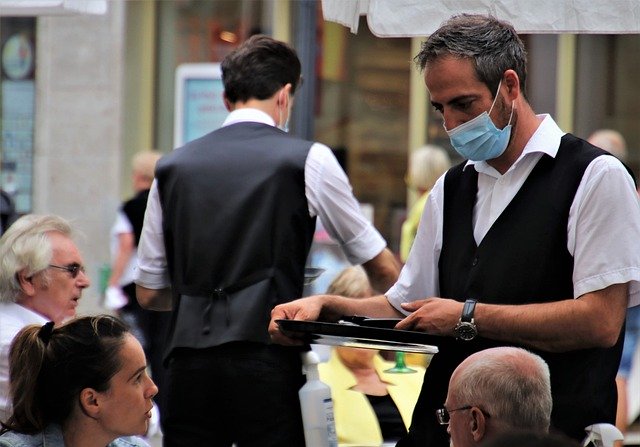Before coronavirus hit, the UK had a thriving coffee shop culture, with around 26,000 coffee shops across the country. But by the end of March 2020 many coffee shops were closed, or only open for takeaway. Up to 92% of coffee shops are estimated to have closed at some point during the lockdown, as it was not viable, or possible, to continue on a purely takeaway basis.
By September 2020, many have reopened, although it is thought that around one third of coffee shops remain closed and some may never reopen. The Eat Out To Help Out scheme, which gave diners big discounts, boosted sales in August. But the amount spent in coffee shops remains significantly reduced, with spending on takeaway hot drinks still at 50% of 2019 levels.
Coffee shops had become important places in many people’s lives, for some as a place to get a caffeine fix on the way to work, for others as a place to gather and meet friends, or as a place to work. In a previous research project I explored how coffee shops were important community spaces in the urban landscape. But this landscape has been completely transformed by COVID-19. The pandemic forced coffee shops to close, or shift their business to a greater focus on takeaway and online sales. And coffee consumers, suddenly with much more time at home, shifted their consumption patterns too.
Coffee drinking during the lockdown
I’m carrying out some ongoing research with coffee drinkers to find out how their consumption patterns have changed over the course of lockdown. So far, a survey I’ve conducted of 1,000 people who regularly visited coffee shops before the pandemic offers some insights into what the future holds for the coffee industry.
Unsurprisingly, people bought more coffee to drink at home, as well as coffee making equipment, during lockdown. Numerous reports detail how sales of coffee soared in supermarkets, as well as direct from coffee roasters too. My research indicates that the most popular pieces of equipment to purchase included a coffee grinder, espresso machine, coffee pod machine, and filter equipment like the V60 and the Aeropress.
In terms of where coffee was purchased, around half of respondents said they had bought more coffee than usual in the supermarket, but over 30% also bought more online from coffee roasters directly. One in ten respondents recognised they needed a steady stream of coffee and started a coffee subscription, recognising that the return to normal wasn’t likely to happen any time soon.
For consumers who bought equipment there was usually also an interest in learning about how to better prepare coffee too, with YouTube being a popular source of information. With their new-found coffee knowledge and equipment there was indication from some that they would be less likely to buy as much coffee in shops going forward, in part because they had invested money on preparing it at home.
A return to the coffee shop?
While there is encouragement from the government to get back to the office, a large proportion of people in the UK are still working from home. This has significant implications for the coffee shops whose customer base is commuters and office workers. It is not surprising that even the large coffee shop chains are having to consider their future. Costa Coffee has said that up to 1,650 jobs are at risk; Pret a Manger is closing 30 outlets, along with cutting nearly 2,900 staff.
For many coffee shop chains, there is the option to reorganise, restructure and scale back activities while uncertainties remain. But for the smaller independents these options are not necessarily available.
Research from coffee industry analysts Allegra revealed that after lockdown restrictions eased 55% of their respondents had visited a coffee shop – this came second only to visiting friends or family. As coffee shops began to reopen, there were scenes of long queues at shops and drive-throughs.
But this does not necessarily paint an accurate picture of what the future holds. While people are visiting coffee shops again, they are not doing so as frequently as before. And this is unlikely to change while working from home remains prevalent and while the risk of COVID-19 remains present. Our research found that around half of respondents intended to visit coffee shops the same amount as before but only when back in a “normal” working pattern. Around 20% indicated they would visit less, primarily because of concerns around getting COVID-19.
This did leave around a third of respondents saying they intend to visit coffee shops more, however. They explained this was because they wanted to support local businesses and also because they felt more connected to their local communities since lockdown. This raises a question about whether the future of the coffee shop industry is less tied to the areas around offices and commuter hubs, but more to the residential areas where people are now spending more time.
For coffee shops to remain a thriving part of where we live and work, they need a regular customer base. Without this the industry will have to change to reflect the new consumption habits of the COVID-19 era.



 One Percent Rule Checklist For Safer Forex Trading Risk
One Percent Rule Checklist For Safer Forex Trading Risk  Proposed Rio Tinto–Glencore Merger Faces China Regulatory Hurdles and Asset Sale Pressure
Proposed Rio Tinto–Glencore Merger Faces China Regulatory Hurdles and Asset Sale Pressure  China’s AI Models Narrow the Gap With the West, Says Google DeepMind CEO
China’s AI Models Narrow the Gap With the West, Says Google DeepMind CEO  White House Pressures PJM to Act as Data Center Energy Demand Threatens Grid Reliability
White House Pressures PJM to Act as Data Center Energy Demand Threatens Grid Reliability  Google Seeks Delay on Data-Sharing Order as It Appeals Landmark Antitrust Ruling
Google Seeks Delay on Data-Sharing Order as It Appeals Landmark Antitrust Ruling  Walmart International CEO Kathryn McLay to Step Down After Two and a Half Years
Walmart International CEO Kathryn McLay to Step Down After Two and a Half Years  China Considers New Rules to Limit Purchases of Foreign AI Chips Amid Growing Demand
China Considers New Rules to Limit Purchases of Foreign AI Chips Amid Growing Demand  Publishers Seek to Join Lawsuit Against Google Over Alleged AI Copyright Infringement
Publishers Seek to Join Lawsuit Against Google Over Alleged AI Copyright Infringement  Boeing Reaches Tentative Labor Deal With SPEEA Workers After Spirit AeroSystems Acquisition
Boeing Reaches Tentative Labor Deal With SPEEA Workers After Spirit AeroSystems Acquisition  Anthropic Appoints Former Microsoft Executive Irina Ghose to Lead India Expansion
Anthropic Appoints Former Microsoft Executive Irina Ghose to Lead India Expansion  BYD Shares Rise in Hong Kong on Reports of Battery Supply Talks With Ford
BYD Shares Rise in Hong Kong on Reports of Battery Supply Talks With Ford  Trump Criticizes NYSE Texas Expansion, Calls Dallas Exchange a Blow to New York
Trump Criticizes NYSE Texas Expansion, Calls Dallas Exchange a Blow to New York  Micron to Buy Powerchip Fab for $1.8 Billion, Shares Surge Nearly 10%
Micron to Buy Powerchip Fab for $1.8 Billion, Shares Surge Nearly 10%  TikTok Expands AI Age-Detection Technology Across Europe Amid Rising Regulatory Pressure
TikTok Expands AI Age-Detection Technology Across Europe Amid Rising Regulatory Pressure  U.S. Moves to Expand Chevron License and Control Venezuelan Oil Sales
U.S. Moves to Expand Chevron License and Control Venezuelan Oil Sales  Jamie Dimon Signals Possible Five More Years as JPMorgan CEO Amid Ongoing Succession Speculation
Jamie Dimon Signals Possible Five More Years as JPMorgan CEO Amid Ongoing Succession Speculation 
































